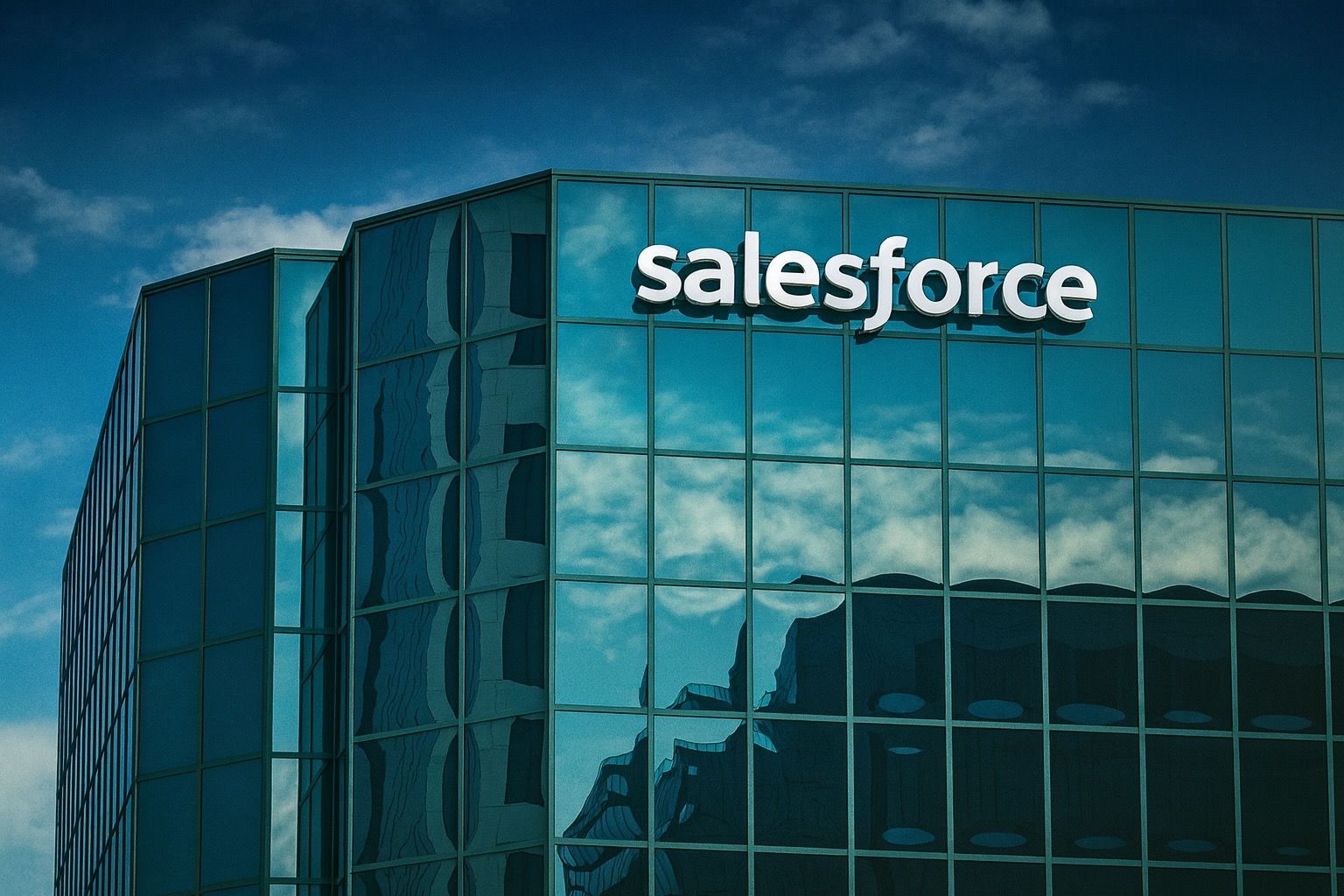- Price Update: As of Oct. 30, 2025, Salesforce (NYSE: CRM) is trading around $258.65 [1]. Its 52-week range is roughly $226–$369 [2], and CRM remains about 27–28% below its early-2025 highs [3] [4].
- Year-to-Date: CRM is down sharply in 2025 [5], lagging the broader market. (For context, the S&P 500 is roughly flat for the year, and tech giants like Microsoft are up ~22% while Oracle has surged ~76% [6].)
- Dreamforce Catalyst: At Dreamforce 2025 (Oct 15–16), CEO Marc Benioff unveiled an aggressive AI-driven roadmap – including a $60 billion revenue target by 2030 (above Wall Street’s ~$58B forecast) – which sent CRM up 4–7% on the news [7] [8]. In extended trading on Oct. 15, the stock spiked about 5% after the announcement [9] [10]. CFO Robin Washington called the results “reaccelerating” [11], underscoring management’s confidence in a rebound.
- Q2 Earnings & Guidance: Salesforce recently reported Q2 FY2026 (period ended July 31) revenue of $10.24B (+10% YoY) and EPS $2.91, beating estimates [12]. The company raised its full-year revenue guidance to roughly $41.1–41.3B [13] [14]. However, management’s Q3 revenue outlook ($10.24–10.29B, ~8–9% growth) was modest and came in below some forecasts [15]. This cautious guidance prompted a market sell-off (shares fell ~5–8% on Sept. 3–4) [16] [17].
- Analyst Sentiment: Most Wall Street analysts remain cautiously positive. Roughly 30–33 analysts rate CRM a Buy, with an average 12-month price target near $330 [18] [19] (implying ~30–40% upside). Price targets vary widely – from Bernstein’s ~$221 (Sell rating) up to Raymond James’s $375 (Strong Buy) [20] [21]. For example, RBC Capital Markets recently set a $250 target (Sector Perform) [22]. Overall consensus is Moderate-Buy/Buy [23] [24].
- Investor Sentiment: Investor mood is mixed. Enthusiasm for Salesforce’s long-term AI vision is tempered by short-term worries. Visible Alpha’s Melissa Otto warned investors may be “frustrated about the timeline for returns on AI investments” [25] after the conservative guidance. Similarly, Hargreaves Lansdown analyst Matt Britzman said the outlook gave the “bears fresh ammo” [26]. On the bullish side, J.P. Morgan sees the sell-off as an opportunity given CRM’s low valuation [27]. Notably, CEO Marc Benioff executed planned sales of about 6,750 shares (~$1.15M) in late October [28] [29]. While these 10b5-1 insider trades are routine, some investors watch them closely. Image credit: TechStock²
- Valuation: At ~20× forward earnings, CRM is trading at a steep discount to peers like Microsoft or Oracle (each ~31×) [30]. In other words, the stock is “relatively cheap” by historical standards [31] [32]. This suggests that if Salesforce can reaccelerate growth (especially via AI), the stock could rebound sharply.
Salesforce Stock: Recent Performance and Key Drivers
Salesforce’s shares have been on a bumpy ride. After hitting a low around $235.69 on Oct. 1 [33] (driven by guidance worries), CRM stabilized in the mid-$230s. The big story came mid-October at Dreamforce, when management rolled out its ambitious plans. The $60B by 2030 revenue projection sparked a market rally: in after-hours trading on Oct. 15, CRM jumped about 5% [34] [35]. By Oct. 16’s close, the stock was trading in the mid-$240s. “We have had some lower-stage growth for a while… that is reaccelerating,” said CFO Robin Washington at Dreamforce [36] – a signal intended to reassure shareholders about a growth rebound.
At the same time, broader tech trends are influencing CRM’s moves. October brought a surge in AI-related stocks (e.g. Nvidia, Microsoft) on renewed AI optimism [37]. Salesforce has leapt on that bandwagon with new AI partnerships (OpenAI, Anthropic, etc.) and product launches (Agentforce 360). However, investors remain sensitive to economic headwinds. A cybersecurity scare in early October (reports that hackers stole data from Salesforce client systems) added caution. Salesforce insists its own cloud was not breached [38], but the incident was a reminder of data risks in the cloud era.
Q2 Earnings and Guidance
On Sept. 3, Salesforce reported Q2 FY2026 results broadly in line with expectations. Revenue of $10.24B (+10% YoY) beat the ~$10.14B consensus [39], and EPS of $2.91 topped the $2.78 forecast. CEO Marc Benioff called it an “outstanding quarter” [40]. The company generated strong margins (its tenth straight quarter of operating-margin expansion) and returned $2.6B to shareholders via buybacks and dividends. Salesforce then raised its full-year revenue outlook to roughly $41.1–41.3B [41], and authorized an additional $20B in buybacks (total $50B). These moves underscored confidence in the long-term plan.
However, management’s Q3 guidance was a mixed signal. For fiscal Q3 (ending Oct 31), Salesforce projected $10.24–10.29B in revenue [42] (about 8–9% growth). This range was slightly below analysts’ models. The market reacted negatively: Salesforce shares fell about 5% after hours on Sept. 3 and another ~8% the following day [43] [44]. Many analysts viewed the guidance as conservative. For example, Melissa Otto of S&P Global noted that investors may feel “frustrated… as they contemplate the timeline for adequate returns on AI investments” [45]. Others, like Rebecca Wettemann (CEO of Valoir), cautioned that Salesforce’s aggressive M&A could draw activist scrutiny [46].
In sum, the earnings season delivered solid results but cautious guidance. Salesforce signaled it is on track for record operating cash flow (~$15B) and double-digit growth in the long run [47] [48], but stopped short of promising an immediate acceleration.
Analysts’ Commentary and Forecasts
Wall Street’s consensus is mostly bullish on CRM, albeit with a wide range of opinions. About 33 analysts rate the stock a Buy, with an average 12-month price target around $332 (≈+40% from current levels) [49]. By number, analysts recommending “Buy” far outnumber “Sell” recommendations (e.g. 25 Buys vs. 1 Sell in one survey) [50] [51].
After Dreamforce, Raymond James reiterated its Strong Buy on Salesforce with a lofty $375 target, calling the new goals “powerful ammo against key bear debates” [52] [53]. On the other hand, some analysts remain cautious: RBC Capital Markets has a $250 (sector perform) target [54], and Bernstein has a sell rating with a ~$221 target [55]. MarketBeat notes a consensus Moderate-Buy rating with a mean target around $325 [56].
Notable commentary: Visible Alpha’s Melissa Otto and Valoir’s Rebecca Wettemann expressed concerns about AI returns and integration, as noted above [57]. Hargreaves Lansdown’s Matt Britzman bluntly said the soft outlook gave “bears fresh ammo” [58]. But JPMorgan’s team countered that CRM’s low valuation provides “room for upside” if growth reaccelerates [59].
Overall, analysts see Salesforce’s mid-$20B buybacks, top-shelf AI products (Agentforce) and strong balance sheet as positives. Yet they caution that macroeconomic headwinds and execution risk may keep a lid on near-term gains. One thing’s clear: nearly every analyst mention surrounds CRM’s AI pivot, underscoring how central artificial intelligence is to Salesforce’s narrative.
Investor Sentiment and Insider Moves
Investors are grappling with a tug-of-war between optimism and uncertainty. On the optimistic side, many see Salesforce as a leader in enterprise AI, with a robust partner ecosystem (e.g. OpenAI, Google) and over 12,000 customers already using its AI agents [60] [61]. The stock’s forward P/E (~20×) is well below peers, suggesting a big upside if AI-driven growth materializes [62] [63].
On the cautious side, traders point to global IT budget cuts, rising rates, and Salesforce’s recent underperformance. Notably, insider selling has raised eyebrows. Between Oct. 10–27, Marc Benioff sold 6,750 shares (totaling about $1.15 million) through pre-arranged plans [64] [65]. While these transactions were planned ahead of time, some view them as a signal that management is booking gains at current prices. An AInvest analysis noted these sales came “amidst market volatility and AI-driven strategic announcements,” and warned that insiders’ moves should be viewed in context [66].
Security is also top-of-mind after the recent cyberattack scare. In early October, a hacker gang claimed to have stolen nearly 1 billion records from Salesforce customer endpoints [67] [68]. Salesforce quickly clarified its own systems were not breached, but the episode reminded investors of the risks tied to cloud data. So far, Salesforce has maintained that customer clouds, not Salesforce’s own, were targeted [69] [70].
Image credit: TechStock²
Industry Context: Peers and Valuation
In a heated tech market, Salesforce’s stock has lagged many of its rivals. As of mid-October, the broad tech rally (fueled by AI hype) saw major indices climb: e.g., the Nasdaq was up on the year thanks to names like Nvidia [71]. Microsoft gained ~22% in 2025 [72], while Oracle nearly doubled on a cloud/digital transformation boom [73]. Even Adobe is down “only” about 25%. In this context, CRM’s ~28% slide YTD sticks out.
Valuation is one reason analysts are cautiously optimistic. Salesforce trades at roughly 20× forward earnings, far below MSFT/ORCL at ~31× [74] [75]. The stock’s depressed multiples imply that any positive surprise – say, faster AI monetization or cost efficiencies – could lead to an outsized move. Conversely, if growth stalls, the multiple compression could deepen.
Finally, broader tech sentiment affects CRM. Cloud software stocks pulled back through late September, partly due to concerns about slowing enterprise IT spending [76] [77]. Going forward, investors will watch sales cycles, subscription renewal rates, and the uptake of new AI features. Salesforce’s shareholder base remains big (market cap ~$240B [78]), so even modest sentiment shifts can cause significant price swings.
What’s Next? Salesforce will report its Q3 earnings (fiscal) in early December 2025. Analysts will look for signs that AI investments (Agentforce, Data Cloud, etc.) are starting to pay off in the numbers. Meanwhile, tech investors will be monitoring macro trends (Fed policy, spending cuts) and any new company announcements (products or partnerships). If Salesforce can deliver on its promises, the stock – currently deeply discounted – could have significant room to run. But if optimism fades, CRM may tread water until clearer results emerge.
Sources: Salesforce press releases, market news outlets, and analyst reports [79] [80] [81] [82]. All quotes and data are cited above.
References
1. www.investing.com, 2. www.marketbeat.com, 3. ts2.tech, 4. ts2.tech, 5. ts2.tech, 6. ts2.tech, 7. ts2.tech, 8. ts2.tech, 9. ts2.tech, 10. ts2.tech, 11. ts2.tech, 12. www.marketbeat.com, 13. ts2.tech, 14. ts2.tech, 15. www.reuters.com, 16. www.reuters.com, 17. ts2.tech, 18. ts2.tech, 19. www.marketbeat.com, 20. ts2.tech, 21. ts2.tech, 22. ts2.tech, 23. www.marketbeat.com, 24. ts2.tech, 25. www.reuters.com, 26. ts2.tech, 27. ts2.tech, 28. www.marketbeat.com, 29. www.ainvest.com, 30. ts2.tech, 31. ts2.tech, 32. ts2.tech, 33. ts2.tech, 34. ts2.tech, 35. ts2.tech, 36. ts2.tech, 37. ts2.tech, 38. ts2.tech, 39. www.marketbeat.com, 40. ts2.tech, 41. ts2.tech, 42. www.reuters.com, 43. ts2.tech, 44. www.reuters.com, 45. www.reuters.com, 46. www.reuters.com, 47. ts2.tech, 48. ts2.tech, 49. ts2.tech, 50. www.marketbeat.com, 51. ts2.tech, 52. ts2.tech, 53. ts2.tech, 54. ts2.tech, 55. ts2.tech, 56. www.marketbeat.com, 57. www.reuters.com, 58. ts2.tech, 59. ts2.tech, 60. ts2.tech, 61. www.ainvest.com, 62. ts2.tech, 63. ts2.tech, 64. www.marketbeat.com, 65. www.ainvest.com, 66. www.ainvest.com, 67. ts2.tech, 68. ts2.tech, 69. ts2.tech, 70. ts2.tech, 71. ts2.tech, 72. ts2.tech, 73. ts2.tech, 74. ts2.tech, 75. ts2.tech, 76. ts2.tech, 77. ts2.tech, 78. www.marketbeat.com, 79. www.reuters.com, 80. www.marketbeat.com, 81. ts2.tech, 82. ts2.tech










